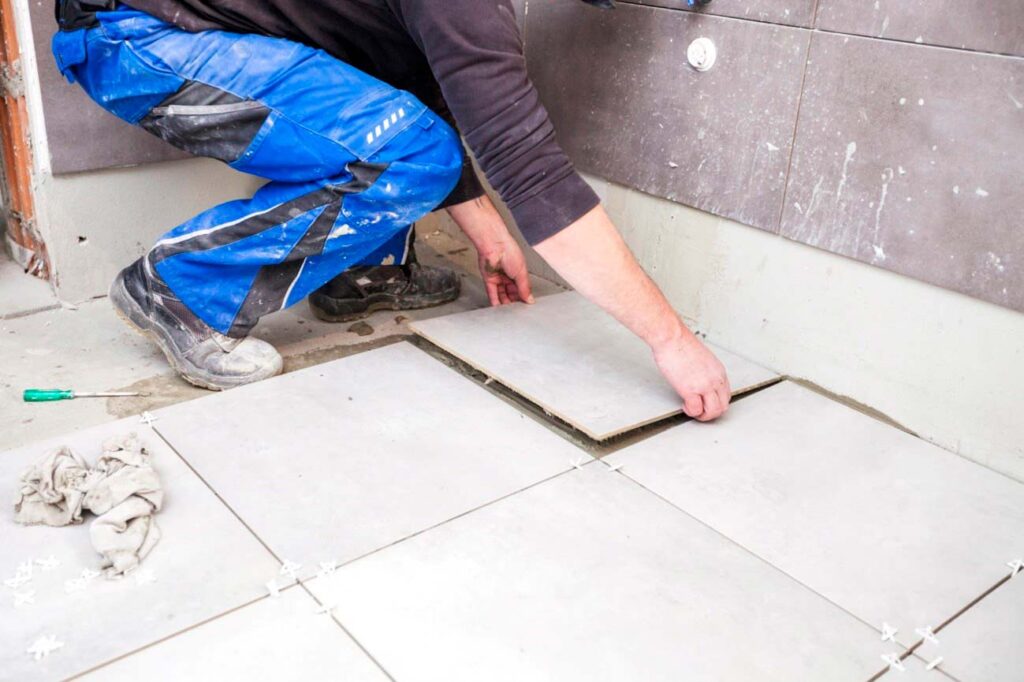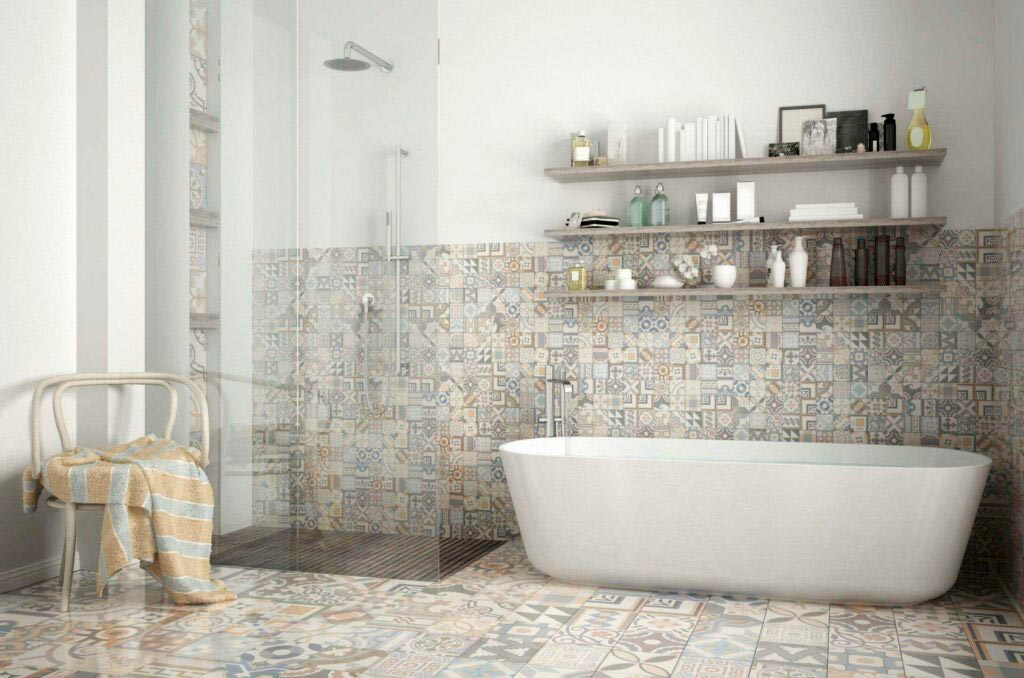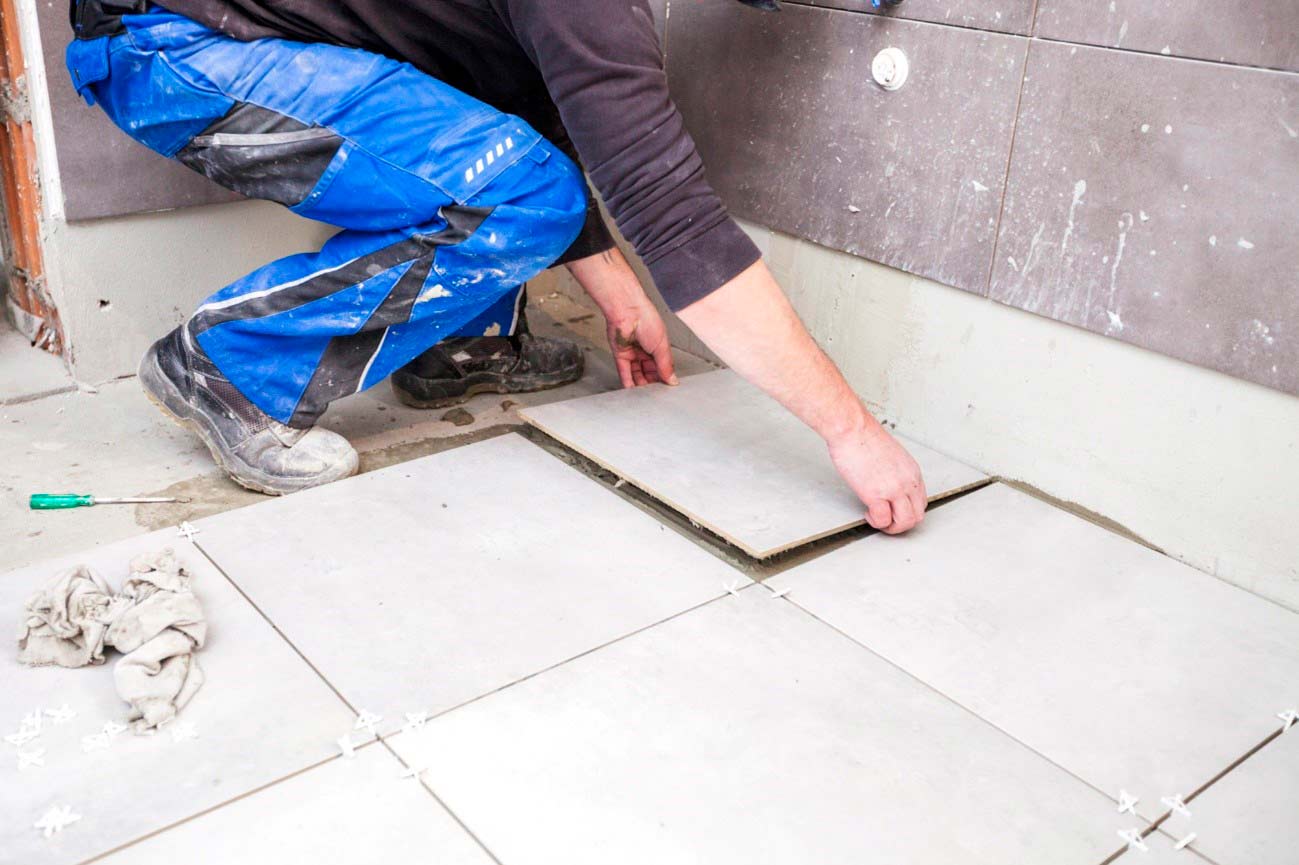Whether you’re replacing an old shabby bathroom floor tile or installing new ones from scratch, you can’t beat a ceramic or stone tile installation when it comes to longevity and appearance. Learning how to lay tile in a bathroom can be an incredibly rewarding experience and it’s often cheaper than you think!
But with that decision comes the responsibility of getting it right. While it is exciting, it can certainly be a daunting task so we’re here to guide you on how to lay tile floors professionally.


1. Gather Your Tools
The number of tools you’ll need will depend on the type of installation you’re doing and how in-depth you plan to go. There are a few essentials you absolutely need if you’re going to do a good job with laying tile in the bathroom. These include a good saw, high-quality mortar and grout, a variety of trowel sizes, and a measuring tape.
Here’s a list of the exact tools we recommend:
- Your tiles
- A RUBI saw
- Tile mortar
- Grout
- Measuring tape
- Tile spacers
- A framing square
- Backer board
- Long level or other straight edge tools
- Thin-set and trowel (various sizes)
- Safety goggles
- Gloves
Make sure you’re protecting your face and hands from flying tile shards and be sure to give yourself ample time to work. Working with bathroom floor tiles (or any tiles) is a game of patience, but the results are worth the effort.
2. Prepare Your Tiling Site
You have two options with site prep. You can work on top of existing tile or clear those out completely and work from a clean base.
If you’re working on top of pre-existing tiles, replace any dented or cracked tiles with spares, as you will need a firm base. Clean them thoroughly and then sand them until they are rough to the touch. Apply a primer to make the surface more porous for your thin-set. Primer is very important because many tile adhesives need porosity to adhere properly.
Removing Existing Tiles
If you’ve decided to remove the tiles, you’re going to want to start by completely stripping your bathroom of any existing tiles, linoleum, or other flooring decorations. If you’re tiling a wall, remove any wallpaper.
You’ll need to remove existing tile before applying a new surface, so ensure you’re doing this properly. If there’s a loose tile, all the better. Remove it by prying it out with a chisel. If you can’t find a loose one, you’ll have to break one.
Once you’ve removed one tile, you should have easy access to the gaps surrounding the rest. You should be able to chisel against the floor with the point of your tool tucked under the tile.
You should be able to remove the old tile adhesive in the same way.
Once you’ve done that, scrub the floor with a vinyl floor stripper using an abrasive pad. The wax and any other residue should dissolve under the stripper and the scouring pad will leave microscopic scratches, and will actually help the mortar bond better, just like sanding existing tiles does.
Assessing Your Floor
Determine how many tiles you’ll need after you’ve prepared your subfloor. To calculate square footage, multiply the length and width of your bathroom floor. Add around 15% extra for mistakes and spare tiles.
If your subfloor is flexible in any way, you’ll almost certainly need to lay a backer board over your vinyl to make it thicker and firm enough for the tiles. If there are uneven areas, you can fill these in as you go with thin-set.

3. How to Lay Tile in a Bathroom
Start by covering your floor with a backer board. Use a saw to cut any necessary shapes. Cut and lay out all your pieces to ensure they fit properly before vacuuming and getting the space as dust-free as possible.
Once you’re ready, prepare your tools and mix your thin-set or prepare your bathroom tile adhesive.
The Steps and Details
It’s important to remember that when cutting tile and measuring where you will lay it, you need to account for the tile joint.
Once you’re ready to tile, this is what you’re going to do:
- Use your trowel to spread the mortar across the floor, working at a 45-degree angle
- Comb in a single direction
- Work in sections to lay thin-set and then a backer board on top (though you don’t need to do this if you didn’t remove existing tiles)
- Place screws every six inches along the edge of each piece
- Place an adhesive tape over the screw joints
- Once the thin-set is firm but not fully set, scrape any ridges away.
- Leave to dry for 24 hours.
Plan Your Bathroom Tile Layout
First, place the center row of tiles between two walls, parallel to your two most dominant walls. Make adjustments as needed, but aim for these goals:
- Use full tiles where you can against doorways and bathtubs, etc.
- Ideally, you want to cut tiles no smaller than half their size
- Avoid difficult cuts and minimize cutting where you can
When working on your layout, carefully place the bathroom floor tiles on the clean ground (with no mortar) and place the tile spacers between them. This will help you get an exact idea of how the tiles look and how many you will actually need for the project. Make sure the tiles are snug against the spacers.
Take a measurement of the tiles once they have been completely laid out. Ensure the distance between the two dominant walls we mentioned is equal. All the tiles in the center of the room should be whole.
If need be, use a level or straight line and make a mark along the floor (instead of relying on your walls to be straight) to mark out where each tile set should go. You don’t need to draw a square for every single tile, but some general large shapes can help a lot.
Tips for Cutting Tiles for a Perfect Fit
When laying tiles in a bathroom, you’ll often encounter situations where full-sized tiles won’t fit around the edges or around fixtures like toilet bases, bathtubs, or shower trays. This is where knowing how to cut tiles accurately comes into play. The key to a perfect finish lies in your ability to make precise cuts so that the tiles fit perfectly and maintain the overall aesthetic of the room.
To achieve this, you’ll need a few tools: a tile cutter for straight cuts or a wet saw for more complex ones. Start by measuring the space where the tile will fit and mark the cut on the tile’s surface. For straight cuts, use a tile cutter – simply score the tile along the marked line, then snap it along the groove. For curves or intricate cuts, a wet saw or tile nippers will be more effective. Wet saws are especially helpful for larger or harder tiles, as they minimise the risk of cracking and provide a smoother finish. Always wear safety gear, like goggles and gloves, when cutting tiles, as the process can generate sharp edges and debris.
If you’re cutting around fixtures, like pipes or corners, it’s important to measure carefully and cut the tiles slightly smaller than needed to allow for small gaps that will be grouted. It’s a good idea to dry lay the tiles first before cutting to double-check that the fit is perfect. And remember, it’s always better to cut a tile too large and trim it down gradually, than risk cutting it too small.
Setting the Tile
Setting tile in two parts is usually the simplest (and most efficient) method. To begin, place all the whole “field” tiles. These are your uncut tiles. Once your thin-set has had time to cure (a few hours), cut and install all the perimeter tiles.
Here are a couple of extra tips to make sure you’re doing the best work you can:
- Use the right trowel size for the scale of the tile
- Combing the adhesive in a single direction will release air bubbles
- Don’t just gently set the tile in place – press and wiggle it in
- Always inspect a section before moving on
- Never extend the life of chunky thin-set. Throw it away and mix more
- Use spacers to keep the gaps between tiles even
Perimeter Tiles
After the mortar beneath the tiles has cured, cut and set the perimeter tiles. If your trowel is too big, comb thin-set on the back of the tiles before laying them down. Where perimeter tiles will meet fixtures like a tub, cut the tile so that caulked joints are as wide as the grout will be.

4. Grouting Your Tiles
Before grouting, be sure to install any transition strips and toilet flanges as needed. This way, you can fill gaps if you see them as you’re grouting.
To start, do the following:
- Mix your grout into a thick “mashed potato” consistency
- Place a few scoops of grout into the corner and work it into the joints
- Work in a back-and-forth motion, staying diagonal to the joints
- Don’t just spread, back the grout in tight
- Scrape off excess grout using your float
Remember, the less grout you leave on the tiles, the less cleanup you’ll have after! When you’re finished, put a plastic bag over the top of the grout bucket and set it aside in a cool place. This will mean you have extra ready-to-go grout if you find spots that need a little more attention.
Always wipe off extra grout with a damp sponge.
5. Applying Sealant
You want to seal your tiles if they’re porous and you know they’ll absorb water. This will stop them from breaking down. You can test how porous your tile is by placing a wet sponge on top of it and leaving it for a minute.
If there is a dark spot on the tile after you’ve moved the sponge, your tile is definitely porous.
Choose a penetrating sealer if you don’t want to use a surface film or a topical sealer with a high-gloss finish. Solvent sealers work best for ceramic or porcelain and water-based sealer is best for natural stone tiles.
To apply the sealant, do the following:
- Vacuum and remove excess dirt and debris
- Mop the floor with soapy warm water
- Scrub the grout to remove stains
- Wash all the soap off the tile’s surface
- Allow the surface to dry for at least 6 hours
- Fill a spray bottle with the sealant
- Hold the bottle about 15cm from the surface and spray a thin coat
- Let it sit for 5 minutes
- Wipe the tile with a damp sponge to remove excess sealant
Ready for More Projects?
Good tiling requires excellent tools, even with the most skilled hands. Learning how to lay bathroom tile is one thing, but trying to do that without the proper tools at your disposal is a recipe for disaster. Invest in your projects and in your skills with RUBI. Check out our wide range of tiling tools suited to your needs and projects.



Post a comment